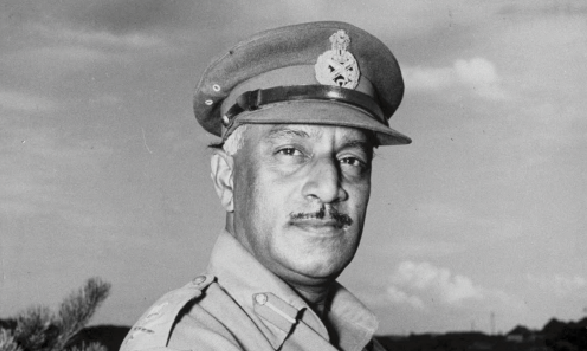General Kodendera Subayya Thimayya, DSO, distinguished soldier of the Indian Army, served as the 6th Chief of Army Staff from 1957 to 1961.
Born in Madikeri, Coorg, Karnataka, to Subayya and Sitamma, he was the third of six children in a family, who were leading coffee planters. After school, Thimayya attended the Prince of Wales Royal Indian Military College. He was one of only six Indian cadets who were selected for further training at the Royal Military College, Sandhurst.
It is with the 4/19 Hyderabad battalion in 1926 that his regimental life began, including his daring foray into the Royal Palace of King Feisal I, where at the risk of his life, he rescued a group of victimised women. Appointed the Regimental Adjutant in September 1930, Thimayya honed his soldiering skills in the Northwest Frontier, battling recalcitrant Pathan tribals. After marriage to Nina in January 1935, Thimayya was posted as an Adjutant at the University Training Corps in Madras, and later posted to his battalion in Singapore.
Later in India, he served as GSO2 (ops) (a grade II staff officer) of the 25th Indian Division, the first Indian officer to get this coveted staff appointment. Commanding the 8 Kumaon in Burma during World War II, exhibiting tactical brilliance in combat, he captured the entire objective, much to the dismay of the Japanese forces. A signatory to the surrender document, he was conferred the Distinguished Service Order (DSO) and also a Mention-in-Dispatches, and also ‘Keys to Manila’ in the Philippines.
His innate talents of professional soldiering were recognised by Field Marshal Sir Claude Auchinleck, Commander-in-Chief of the Indian Army, who specially selected him to lead the 268th Indian Infantry Brigade, part of the British Commonwealth Occupation Force in Japan after World War II. The British, as a policy, avoided giving operational command to Indians, but Thimayya was an exception.
After Partition, he was on the committee for allotment of weapons, equipment and regiments between India, and Pakistan. As Major-General, he commandeered the 4th Infantry Division and the Punjab Boundary Force, dealing with the exodus and intake of refugees.
A member of the Indian delegation that concluded the Treaty with Pakistan with respect to the Line of Control (LoC) under the auspices of the United Nations Commission for India and Pakistan, it was his tactical manoeuvres in what is known as the first Kargil War in 1948 that helped save Kargil, which we had lost to Pakistan.
A unique honour came when he was selected Chairman of the Neutral Nations Repatriation Commission (NNRC) in Korea in May 1953, a sensitive and delicate task dealing with prisoners. His deft handling got him a Padma Bhushan in 1954.
At 51, Gen.Thimayya achieved the pinnacle of military success by being appointed the 6th Chief of the Army Staff. He recommended an offensive posture against Pakistan, and a policy of containment coupled with strong diplomatic and political exchange vis-á-vis China. He disagreed over matters of policy and strategy with Krishna Menon and Nehru. This discord led perhaps to India’s defeat at the hands of the Chinese, fifteen months later.
He retired from the Army after 35 years, and was President of the Planters Association of South India, and also elected President (later Patron) of the Old Cottonians’ Association. The United Nations then sought his service in July 1964 as the Commander of a 6000 multi-national U.N. Peace Keeping Force in Cyprus which at that point, was gripped by the bitter conflict between Greeks and Turkish Cypriots.
He unfortunately died, aged 59, of heart attack, on 18 December 1965. The Republic of Cyprus, issued a 1966 commemorative stamp. The Bishop Cotton Boys’ School, of which he was an alumnus, annually holds the General K.S. Thimayya Memorial Lecture Series; the General Thimayya National Academy of Adventure is representative of his spirit of adventure, in thought, philosophy, and action, and there is also the General K.S. Thimayya Memorial Museum in Madikeri, where weapons used by the Indian soldiers are exhibited.


 [/column]
[/column]